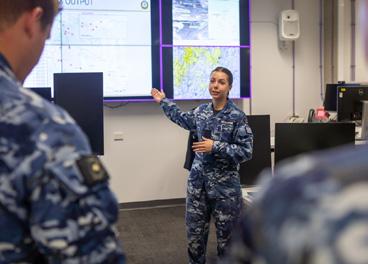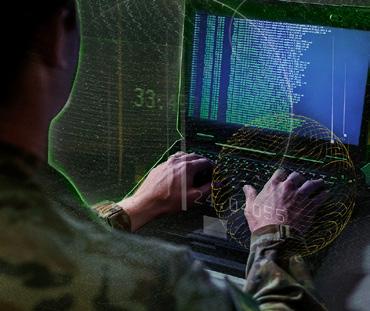
6 minute read
TECH BRIEF - SIGINT Signals Intelligence explained
from ADBR JUL-AUG 2020
by adbr5
TECH BRIEF
SIGNALS INTELLIGENCE 101
Advertisement
On March 20 2003 hundreds of US and coalition aviators prepared for what would be the start of Operation Iraqi Freedom (OIF).
The opening missions of the “shock and awe” campaign saw hundreds of aircraft attack the ‘Super-MEZ’ – the missile engagement zone protecting Baghdad and the Iraqi regime. Their targets were surface-to-air missile and anti-aircraft artillery batteries, as well as command and control installations.
In the preceding years. through the first Gulf
War of 1991 and the follow-on Operations Northern and Southern Watch, Iraqi forces had learned the consequences of keeping their anti-air systems static and became increasingly mobile, employing
‘shoot-and-scoot’ techniques to avoid the onslaught of coalition attacks. But while this provided a challenge to the coalition forces, they had a powerful weapon supporting their mission.
In the weeks and months leading up to
March 2003, a large intelligence, surveillance, and reconnaissance (ISR) campaign had been collecting intelligence on the Iraqi forces, analysing their locations, plans and intent. A key part of this
ISR effort was signals intelligence – or SIGINT – combining the capabilities of national space-based collectors with airborne collection platforms.
SIGINT provided continuous updates as systems came online in new locations and threatened the air campaign above. While all this was happening, there was also significant effort being made in collecting and analysing communications intelligence – or
COMINT – to identify leadership targets, their plans and intent. Overall, SIGINT made a significant contribution to the efforts to degrade the Iraqi antiair capability in Baghdad, paving the way for followon operations in and around the Iraqi capital.
SIGINT is one of the many intelligence disciplines that feeds information into the intelligence cycle and comprises intelligence derived from electronic signals and systems such as communications, radars, and weapons systems. SIGINT is comprised of two main sub-disciplines – COMINT and
BY DAVID HOPKINS
electronic intelligence, or ELINT.
SIGINT provides intelligence on adversary capabilities, disposition, composition, actions, and intent. Demand for SIGINT has grown exponentially in the last decade, for its utility in understanding capability and intent of adversaries. As well as providing vital intelligence against the rise of terrorism, SIGINT is crucial in supplying 5th gen military platforms with the mission data they need to achieve advantage in the battlespace.
SIGINT has its origins in the interception of German radio traffic in the early years of World War I, with the intercepted radio traffic providing insight into German plans and operations. Attempts to encrypt radio traffic led to cryptography becoming a central part of SIGINT analysis. Since the start of the Cold War, a significant number of space-based signals collection capabilities have been launched, collecting SIGINT alongside military air, land, and maritime-based capabilities.
Militaries, governments, and nations rely on the ability to communicate to achieve their national security objectives, be it during peace, contest, or conflict, and much of this communication occurs using radio, satellite communications, telephone networks, or the internet, and all these means are vulnerable to interception. ‘Since the start of the Cold War, a In fact, the more connected we become, the more opportunities significant number of space-based signals there are for communications to be intercepted. collection capabilities have been launched’
COMMUNICATIONS INTELLIGENCE – COMINT COMINT is intelligence gathered from the interception of communications between people and groups, and is focused primarily on the translation and interpretation of the actual conversations or messages being passed. Sources of COMINT include radio messages, telephone conversations, text messages, and emails.
Intelligence derived from the translation and analysis of COMINT can provide valuable insight into enemy intent, plans, and operations, as well as identifying individuals and their responsibilities in an organisation. Intelligence agencies rely on large numbers of security-cleared people to manually translate and interpret the thousands of hours of communications intercepted each day.

ELECTRONIC INTELLIGENCE – ELINT ELINT is technical intelligence gathered using electronic sensors to collect electromagnetic (EM) emissions from systems. Sources of ELINT include radars, radio and datalinks, GPS and navigation equipment. ELINT contributes to understanding of the technical capabilities of the system transmitting the signals, and insight into the location and operating patterns of the force using the system.
Analysis of the collected technical signals (Tech ELINT) can determine information such as the type of equipment generating the signal, the frequency, wavelength, and other attributes. The collected information can then be analysed to determine the capabilities of the system. and to plan countermeasures. Tech ELINT can be collected in the early stages of a new system’s development, sometimes referred to as foreign instrumentation signals intelligence, where telemetry and instrumentation of a system being tested is collected. It can take years to collect, interpret, analyse, and build into useable databases.
In contrast, operational ELINT (Op ELINT) is focused on detecting the location and operating patterns of a system and can provide timecritical intelligence during the execution of operations. Electronic support, a sub-discipline of electronic warfare, overlaps with ELINT. While electronic support is focused on the immediate detection of threats, much of the information is recorded and can be analysed to produce both Op and Tech ELINT. SIGINT OPERATIONS Like all intelligence sources, SIGINT is tasked, collected, processed, analysed, and disseminated. It provides intelligence at the strategic level to inform national security decisions, at one end of the spectrum, and provides real-time intelligence to tactical commanders across defence and security forces at the other. SIGINT is a key component of a military ISR system.
In support of military ISR operations, SIGINT provides a nearly continuous feed of intelligence that contributes to situational awareness. Military platforms are fed from databases built from Tech ELINT, and many are fitted with sensors that collect COMINT and ELINT while conducting their missions in the battlespace. SIGINT from national intelligence agencies and military platforms is fused and presented to operational commanders to contribute to their situational understanding and decisionmaking advantage.
A CHALLENGING FUTURE SIGINT is playing an ever-increasing role in the understanding, location and targeting of adversary forces. The next generation of SIGINT capabilities will have to deal with three key challenges – increasing demand, rapid advances in technology, and the pace at which policy can keep up.
Demand for SIGINT is growing from traditional users such as military forces and newer users in the broader national security environment. This will drive the need for more collection, data processing and storage, and faster processing, exploitation, and dissemination of intelligence as part of a broader ISR system. It will force the adoption of technologies such as machine learning to process data and artificial intelligence (AI) to exploit and analyse the data.
Rapid technology advances are providing an increasingly complicated challenge as new collection capabilities are quickly countered, shortening the lifespan of the advantage gained. One of the biggest emerging challenges facing SIGINT is that of encryption. Commercial encryption is rapidly advancing and decreasing in price, and research into quantum encryption is showing early signs of success. As potential adversaries invest in improving the resilience of their communications, SIGINT capabilities will need to evolve faster. However, to enjoy the same advantages experienced in 2003 during Operation Enduring Freedom, the biggest challenge may not be that of technology. While SIGINT policy and regulations have adapted to changing technology, the pace of change does not match that of technology.
David Hopkins is an Executive Analyst at Felix Defence. He is a graduate of the Fighter Intelligence Instructor Course and has more than 20 years’ experience in the Royal Australian Air Force. He is a veteran of multiple tours across the Middle East theatres of operation.








